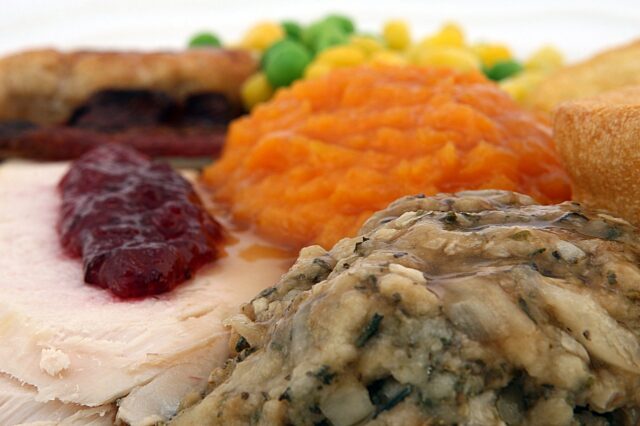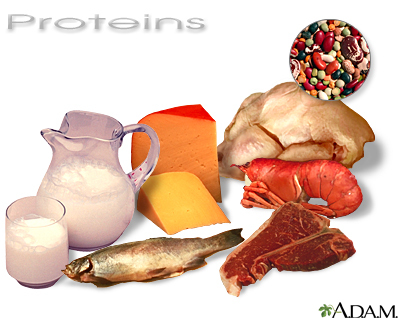Thanksgiving and your taste buds
Ready to carve that turkey and dig into a slice of pumpkin pie slathered with whipped cream? Maybe the broccoli casserole and sweet potatoes sound more…

Update your location to show providers, locations, and services closest to you.
Proteins are the building blocks of life. Every cell in the human body contains protein. The basic structure of protein is a chain of amino acids.
You need protein in your diet to help your body repair cells and make new ones. Protein is also important for growth and development in children, teens, and pregnant women.
Diet - protein
Protein foods are broken down into parts called amino acids during digestion. The human body needs a number of amino acids in large enough amounts to maintain good health.
Amino acids are found in animal sources such as meats, milk, fish, and eggs. They are also found in plant sources such as soy, beans, legumes, nut butters, and some grains (such as wheat germ and quinoa). You do not need to eat animal products to get all the protein you need in your diet.
Amino acids are classified into three groups:
Essential amino acids cannot be made by the body, and must be supplied by food. They do not need to be eaten at every meal. The balance over the whole day is more important.
Nonessential amino acids are made by the body from essential amino acids or in the normal breakdown of proteins.
Conditional amino acids are needed in times of illness and stress.
The amount of protein you need in your diet will depend on your overall calorie needs. The daily recommended intake of protein for healthy adults is 10% to 35% of your total calorie needs. One gram of protein supplies 4 calories. Therefore, a person on a 2000 calorie diet could eat 100 grams of protein, or 400 calories from protein, which would supply 20% of their total daily calories.
One ounce (30 grams) of most protein-rich foods contains 7 grams of protein. An ounce (30 grams) equals:
Low fat dairy is also a good source of protein.
Whole grains contain more protein than refined or "white" products.
Children and teens may need different amounts, depending on their age. Some healthy sources of animal protein include:
Other good sources of protein include:
The US Department of Agriculture's newest food guide, called MyPlate, can help you make healthy eating choices.

National Academy of Sciences, Institute of Medicine, Food and Nutrition Board. Dietary Reference Intakes for Energy, Carbohydrate, Fiber, Fat, Fatty Acids, Cholesterol, Protein, and Amino Acids. National Academy Press. Washington, DC, 2005. nap.nationalacademies.org/catalog/10490/dietary-reference-intakes-for-energy-carbohydrate-fiber-fat-fatty-acids-cholesterol-protein-and-amino-acids.
Ramu A, Neild P. Diet and nutrition. In: Naish J, Syndercombe Court D, eds. Medical Sciences. 3rd ed. Philadelphia, PA: Elsevier; 2019:chap 16.
US Department of Health and Human Services and US Department of Agriculture. 2015-2020 Dietary Guidelines for Americans. 8th ed. health.gov/dietaryguidelines/2015/resources/2015-2020_Dietary_Guidelines.pdf. Updated December 2015. Accessed August 16, 2021.
Ready to carve that turkey and dig into a slice of pumpkin pie slathered with whipped cream? Maybe the broccoli casserole and sweet potatoes sound more…

What’s better than a sizzling ribeye steak or a savory chicken breast? For many Americans, the answer is: not much. And what do these two delectable dishes have in common? They’re both sources of...
The idea that you are what you eat has some special relevance when it comes to babies. Infants’ growth patterns are influenced by the type of protein they eat during their first year of...
Many fad diets lurking around the internet today suggest eating sufficient amounts of “lean protein.” Protein shakes are a common staple among fitness buffs. In fact, previous research has shown...